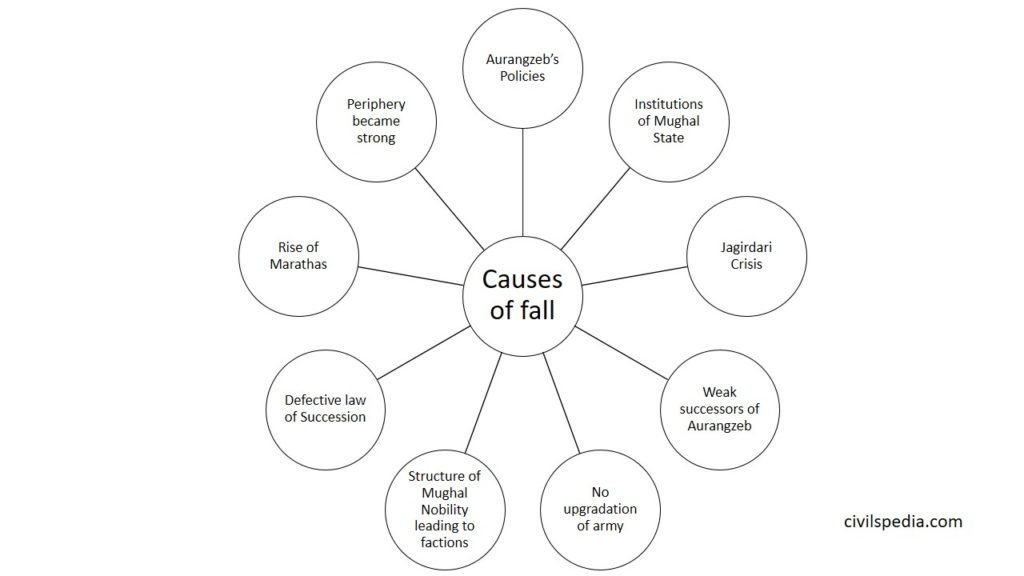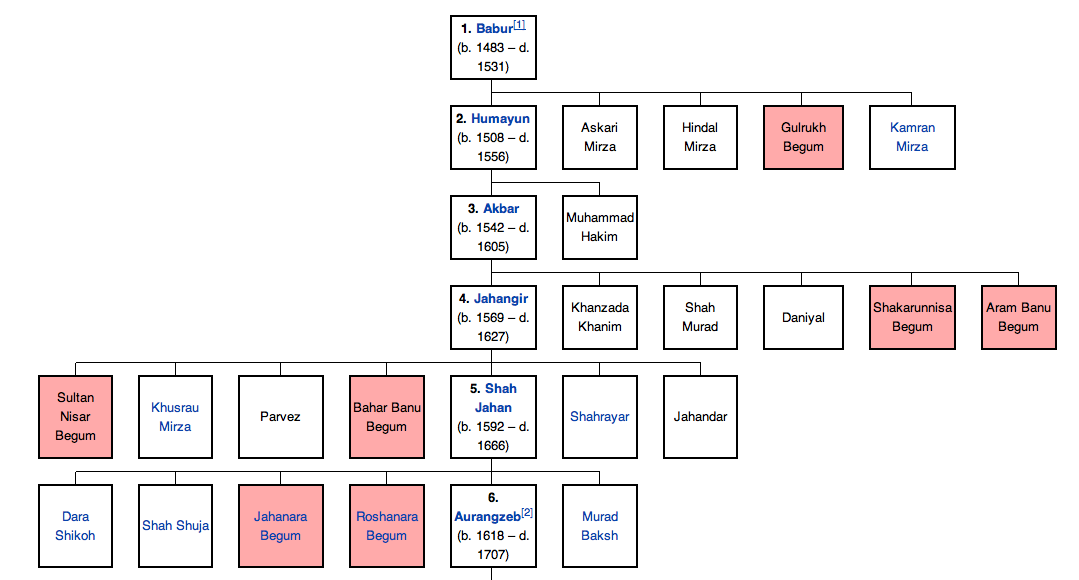
SOLUTION Mughal empire flow chart Studypool
1556-1605 Mughal Empire The Mughal Empire was established in the northern part of the Indian subcontinent in the 1520s. By the early 1700s the Mughals had conquered most of the subcontinent, except the far south. Encyclopædia Britannica, Inc. Humāyūn's son Akbar consolidates the Mughal Empire.

Spectrum Educational Charts Chart 297 Mughal Period
Mughal emperors The Mughal emperors were the supreme monarchs of the Mughal Empire in the Indian subcontinent, mainly corresponding to the modern countries of India, Pakistan, Afghanistan and Bangladesh. They ruled parts of India from 1526, and by 1707, ruled most of the subcontinent.

Causes of Decline Of The Mughal Empire DataFlair
Emperors Jahāngīr (left), Akbar (centre), and Shah Jahān (seated at right) are depicted with their ministers and Prince Dārā Shikōh in a watercolour from India from the 1600s. Development of the Mughal Empire Mughal dynasty, Muslim dynasty of Turkic-Mongol origin that ruled most of northern India from the early 16th to the mid-18th century.

MUGHAL PERIOD CHART SIZE 45 X 57 CMS
Flow Chart of Mughal Empire | PDF | Mughal Empire | Timurid Dynasty Flow Chart of Mughal Empire - Read online for free.

Reasons of fall of Mughal Empire
SUMMARY OF THE MUGHAL EMPIRE; Flow Chart Of The Mughal Kings; videos of the rulers; PPT ON THE MUGHAL EMPERORS; QUESTION AIR; Submit your project; Flow Chart Of The Mughal Kings. RULERS.

Mughal Empire Family Tree ganesh Medium
Fig. 1 The Red Fort. Who were the Mughals? The Mughals were descendants of two great lineages of rulers. From their mother's side they were descendants of Genghis Khan (died 1227), ruler of the Mongol tribes, China and Central Asia.

Military of the Mughal Empire
The Mughal Empire reached the zenith of its territorial expanse during the reign of Aurangzeb and also started its terminal decline in his reign due to Maratha military resurgence under Shivaji Bhosale. During his lifetime, victories in the south expanded the Mughal Empire to more than 3.2 million square kilometres (1.2 million square miles.

family tree of mughal empire Ancient history facts, Indian history facts, Ancient history timeline
The Mughal dynasty in India is founded by Bābur, a descendant of Mongol conqueror Genghis Khan and of Turkic conqueror Timur ().The Mughal Empire, Mogul or Moghul Empire, was an early modern empire in South Asia. For some two centuries, the empire stretched from the outer fringes of the Indus basin in the west, northern Afghanistan in the northwest, and Kashmir in the north, to the highlands.

Mughal Emperors Family Tree Royal family trees, Family tree, Mughal
Culture. Mughal culture was a blend of Persian and Indian elements. The empire produced rich literature, art, and music, including miniature paintings. The Mughals were patrons of the arts and promoted cultural diversity. The Mughal Empire practice Sunni Islam. Akbar the Great practiced religious tolerance, but not all leaders did the same.

Pin on data
Last Updated on : 09/10/2013 Live Cricket Score Villages in India Family Tree and genealogy of Mughals. Find the flow chart of mughal emperors from Timur to Bahadur Shah Zafar.

draw a flowchart of ancient mughal Kings and they time of ruling Brainly.in
The Mughal state was established by the Sultan Babur in the sixteenth century, with his legendary victory over the Lodhi Sultan in 1526. Babur used 20 cannons to defeat an army twice the size of his own. But he died two years later, so it wasn't really Babur's leadership that sustained his dynasty.

History chart of mughal emperor Brainly.in
THE SUR DYNASTY (1540-55) AND THE MUGHAL RESTORATION (1555-6)¯ Sher Shah S¯ ur (1540-5) founded an empire that included not only the territories of the¯ old Lodi empire, but also Bengal, Malwa, much of Rajasthan and Multan. During his five-year reign, he was continuously engaged in military operations and died as the result of a

Timeline Of Mughal Dynasty
The Mughal Empire, descendants from the Mongol Empire of Turkestan in the 15th century, ruled the majority of India and Pakistan during the 16th and 17th centuries. Although this was an Islamic empire, the Mughals tolerated other religions even as they spread Muslim art, faith, and culture.

The Mughal Empire IndiaSpeaks
India - Mughal Empire, 1526-1761: The Mughal Empire at its zenith commanded resources unprecedented in Indian history and covered almost the entire subcontinent. From 1556 to 1707, during the heyday of its fabulous wealth and glory, the Mughal Empire was a fairly efficient and centralized organization, with a vast complex of personnel, money, and information dedicated to the service of the.

Leaders and Social Structure Mughal Empire
The list of Mughal emperors who ruled India is given below: Aspirants can also go through India under the Mughal for detailed information on the Mughal rule in India. Also read, Akbar's Successors Humayun 1530 -1556 Important dynasties and kingdom of Ancient India Mughal Emperors - Sample Questions & Answers

Family Tree of Mughals Family tree, Indian history facts, Royal family trees
The Mughal Empire stretched across most of northern and central India, and what is now Pakistan, from 1526 to 1857, when the British exiled the last Mughal emperor.Together, the Muslim Mughal rulers and their predominantly Hindu subjects created a golden age in Indian history, full of art, scientific achievement, and stunning architecture.